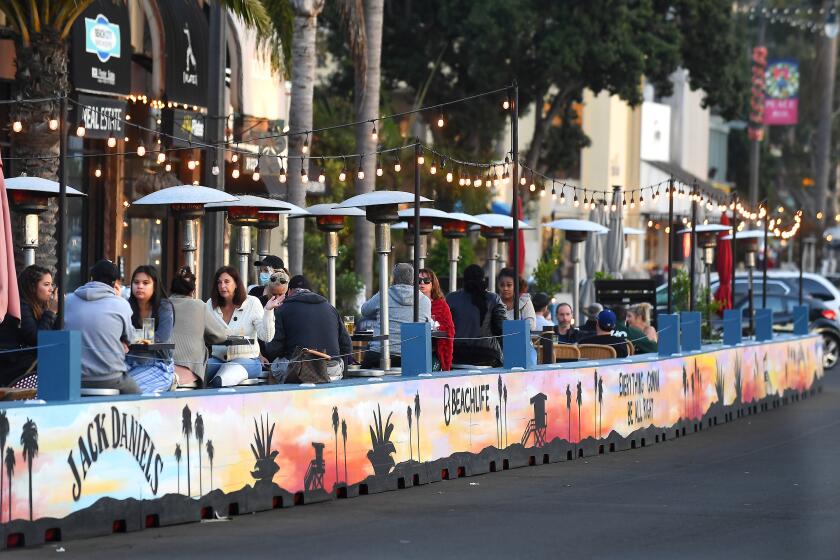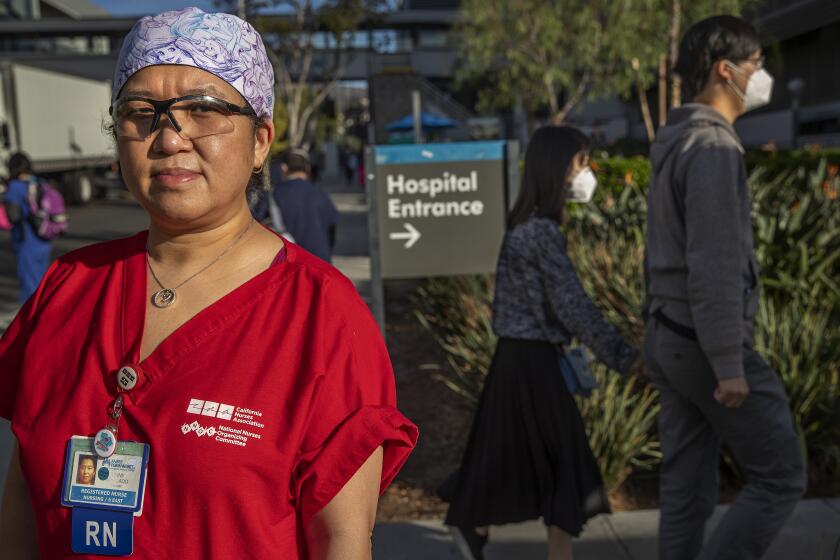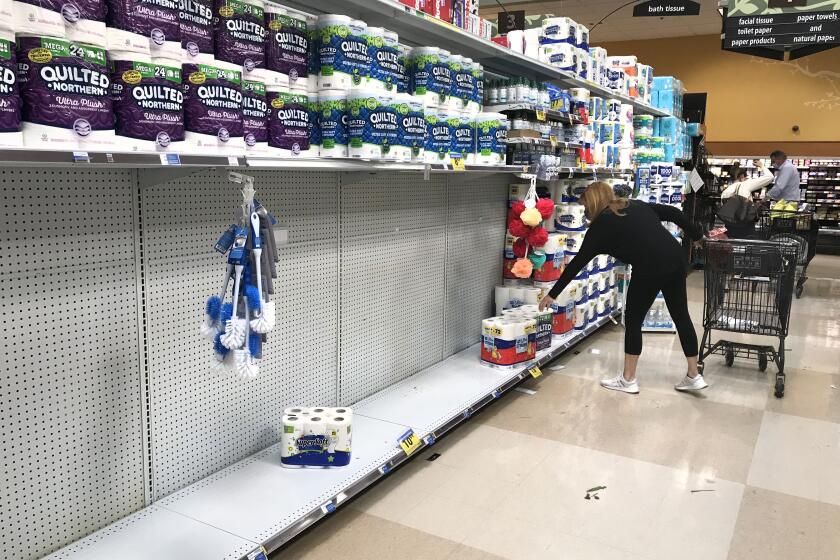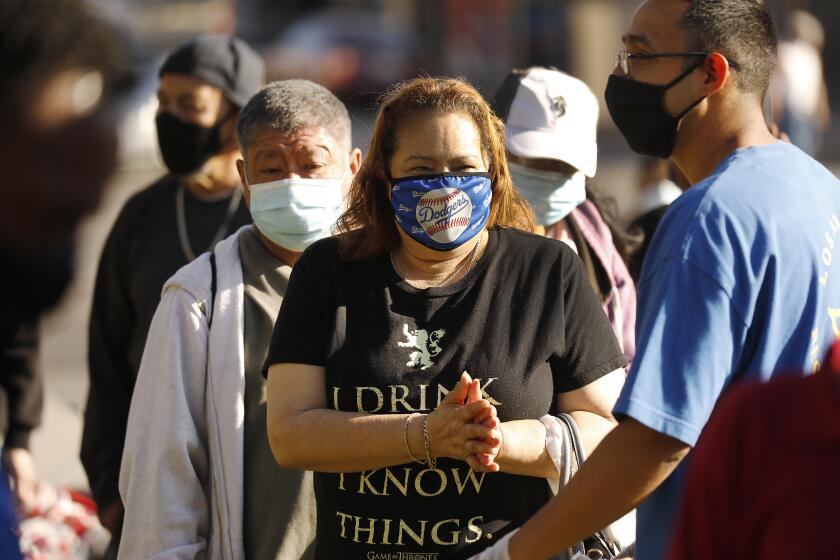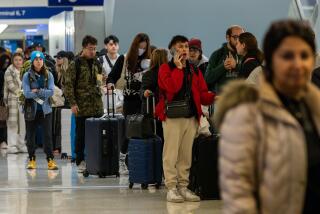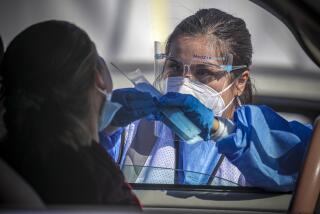Daily California coronavirus cases triple as pandemic dramatically worsens
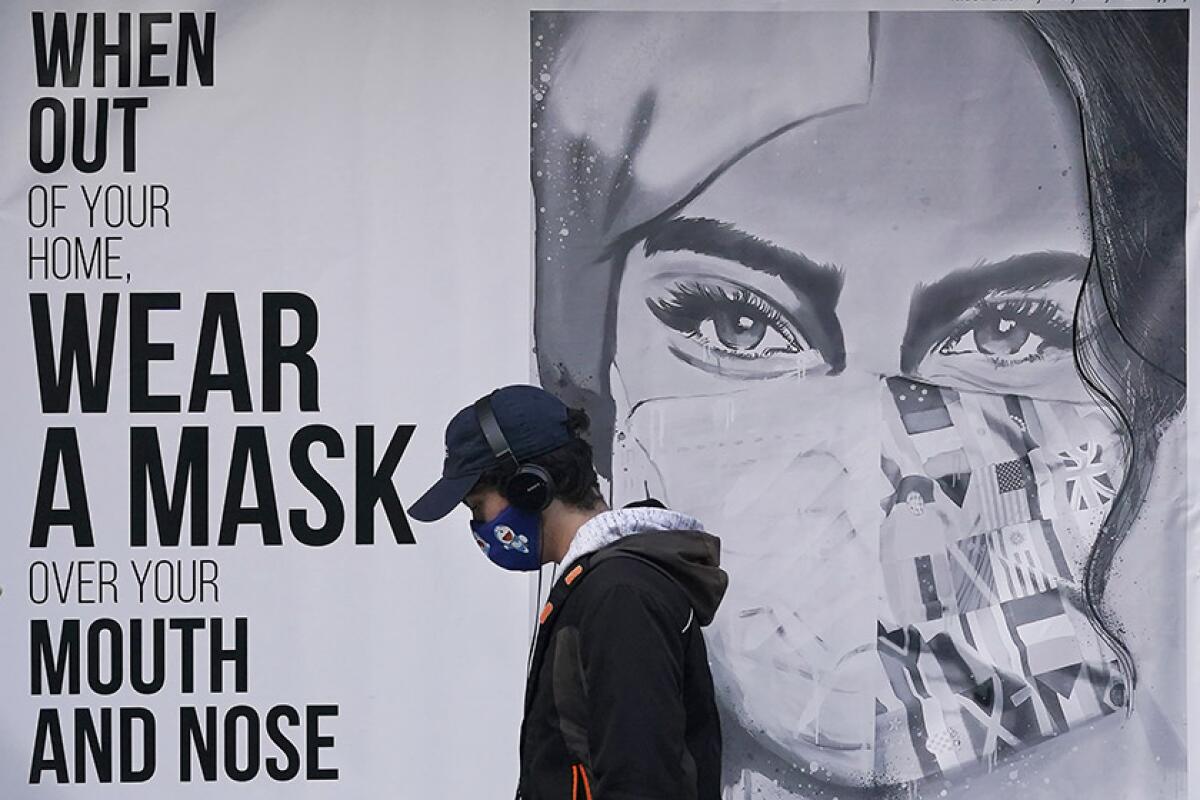
SAN FRANCISCO — California’s average daily number of new coronavirus cases has tripled in the last month, a Times analysis has found, as pandemic conditions deteriorated dramatically around the state.
The coronavirus is now infecting more Californians daily than at any previous point in the COVID-19 pandemic, raising concerns about a new peak in coronavirus-related deaths by Christmas.
As of Saturday night, California was averaging more than 11,500 new coronavirus cases a day over the last seven days, more than triple the number a month earlier, on Oct. 21, which was nearly 3,200, according to a Times analysis.
Even during the summertime surge, which led to the season with California’s worst COVID-19 death toll, the average daily number of coronavirus cases over a seven-day period never exceeded 10,000.
COVID-19 hospitalizations have doubled in the last month, the analysis found. And COVID-19 deaths have suddenly begun to climb in recent days. In the last week, an average of 65 Californian deaths have been reported daily, a more than 50% increase from two weeks ago, when 43 fatalities were reported daily on average.
The rate at which coronavirus tests in California are coming back positive was up dramatically in the last week — a troubling indication of the rapid spread of the highly contagious virus. On Saturday, the coronavirus positivity rate hit 6.1%, double the percentage it was Nov. 1, when the rate was 2.98%.
L.A. County public health officials on Saturday announced they will issue an order suspending outdoor dining at restaurants amid a surge of new coronavirus cases.
On Saturday, San Diego and San Bernardino counties both recorded their highest single-day coronavirus case totals in the history of the pandemic, according to health officials.
Los Angeles County on Sunday crossed a grim marker that will require outdoor restaurant dining areas to shut down starting Wednesday at 10 p.m., officials said, for at least three weeks.
The new rule restricts eateries to serving food only by takeout and delivery for the first time since May. “New COVID-19 cases remain at alarming levels and the number of people hospitalized continue to increase,” the L.A. County Department of Public Health said in a statement.
A new surge of COVID-19 is battering Southern California, bearing down on exhausted healthcare workers, raising anxiety levels on hospital wards and stoking fears that there might not be enough staff and supplies for the difficult weeks ahead.
As of Sunday, officials said L.A. County was averaging more than 4,000 cases a day over the last five days — more than double the number from just two weeks ago. Officials had previously said exceeding that number would force authorities to close outdoor dining areas at restaurants.
Should L.A. County average 4,500 cases daily over a five-day period, officials have warned that they will impose a springtime style stay-at-home order.
Daily deaths are also starting to climb in L.A. County. On Saturday, an average of 23 COVID-19 deaths a day were reported in Los Angeles County over the previous seven days; that’s double the figure from early November, when about 11 people were dying a day.
There are a number of reasons for the sudden increase in coronavirus cases in California, where a surge began in late October.
A modified stay-at-home order goes into effect for the much of California as of Saturday morning to try to slow the rapid spread of the coronavirus.
They include the colder weather, which encourages people to stay indoors; increased travel from other harder-hit states; gatherings to watch the NBA Finals and the World Series, won by the Lakers and Dodgers, respectively; Halloween; protests and celebrations related to the election; a general increase in social gatherings; an increase in workplace outbreaks; a premature feeling that the danger of the pandemic had passed; and fatigue and even resentment of continuing with COVID-19 safety precautions, according to state and local health officials.
Though outdoor events are relatively less risky than indoor events, they can still result in superspreading events, especially if people do not wear masks and do not stay six feet from one another. A White House Rose Garden ceremony in September formally introducing Amy Coney Barrett as President Trump’s nominee to the Supreme Court resulted in several infections despite taking place outdoors.
Cumulatively, California has recorded 1.1 million coronavirus cases and more than 18,700 deaths. Nationally, more than 12 million coronavirus cases have been diagnosed and more than 256,000 people in the U.S. have died.
Federal, state and local authorities are urging people to stay home for Thanksgiving and abandon travel plans, whether it be a cross-country plane flight or a drive across town, to avoid spreading the virus at celebrations. The virus can be transmitted by people who seem perfectly healthy and never fall sick.
A travel advisory issued by California in mid-November implored residents to avoid nonessential out-of-state travel and asks those who arrive from outside of the state to quarantine for 14 days, meaning they should stay at home or other lodging as much as possible during that time and order food by delivery.
L.A. County’s director of public health, Barbara Ferrer, urged college students living on campus to not return home just for the Thanksgiving holiday. Students who do end up returning home for a month or more, she said, should quarantine in separate rooms for as much as possible for a 14-day period. If they haven’t yet returned home, she advised that it’s too late for them to partake in communal Thanksgiving celebrations, which risks spreading the virus to the rest of the family and friends.
Officials say it’s safest to keep Thanksgiving celebrations just among people in the household. For people who do intend to invite others from outside their household to gatherings, a state health order says such gatherings in most areas of the state must be held outside, with the host and guests coming from no more than three households, people from different households kept six feet apart from another, and everyone asked to wear masks when not eating or drinking. In L.A. County, those gatherings are capped at no more than 15 people.
COVID-19 has already killed more than double the number of people in L.A. County than died of the flu in the last cold-and-flu season. “This should serve as a severe demonstration of how much more dangerous COVID-19 is than the flu,” L.A. County Health Officer Dr. Muntu Davis said Thursday.
Another round of distressing COVID-19 case numbers has Los Angeles teetering on the brink of further restrictions to slow the spread of the virus — including the likely shutdown of outdoor restaurant dining.
Last week, Los Angeles County issued an advisory urging people to stay home as much as possible for the next two to three weeks. On Friday, a new health order went into effect that ordered nonessential businesses to shut their doors to the public between 10 p.m. to 6 a.m.; although takeout and delivery services may continue during those overnight hours.
On Saturday, California’s new limited overnight stay-at-home order went into effect in counties in the most restrictive COVID-19 tier, which covers 94% of California’s population. It’s aimed at being far less intrusive than the statewide stay-at-home order implemented in the spring, and designed to curb late-night drinking and group gatherings, where inhibitions are lowered, masks are taken off and the virus can easily spread.
The order prohibits all gatherings between 10 p.m. to 5 a.m. among people from different households and all nonessential activities outside the home with people from other households.
The order does allow people to leave their homes in the overnight hours to go grocery shopping, pick up takeout food, walk the dog, and work for essential businesses, which includes working for restaurants serving food for takeout and delivery.
Experts say similar government-ordered limits on late-night activity in Europe have helped drive down surges in the coronavirus there.
The surge in cases has been seen across the state. Here is an analysis by region among selected counties in California’s most populated areas as of Saturday night. More detailed analysis for all of California’s 58 counties can be found on The Times’ California coronavirus tracker website.Southern California
San Diego County: More than 1,000 coronavirus cases were reported daily on average over the last seven days, nearly quadruple the figure from a month ago. On Saturday, 1,478 coronavirus cases were reported, the highest number recorded in any single day thus far in the pandemic in San Diego County.
Orange County: About 650 coronavirus cases were reported daily on average over the last seven days, roughly quadruple the figure from six weeks ago. On Friday, 1,169 cases were reported, the highest single-day figure since early July.
Riverside County: More than 600 coronavirus cases were reported daily on average over the last seven days, about double the figure from a month ago.
San Bernardino County: More than 1,460 new coronavirus cases have been reported daily on average over the last seven days. That figure is six times worse than the rate roughly a month ago, when San Bernardino County averaged more than 235 coronavirus cases daily over a seven-day period. On Saturday, 2,873 coronavirus cases were recorded, the highest number recorded of any single day thus far in the pandemic in San Bernardino County.
Ventura County: More than 220 coronavirus cases were reported daily on average over the last seven days, roughly quadruple the figure from a month ago. More than 400 new infections were reported Friday.
Bay Area
San Francisco: More than 115 coronavirus cases were reported daily on average over the last seven days, quadruple the figure from mid-October. On Friday, 210 cases were reported, the third highest single-day tally so far in the pandemic, and the worst since July.
Santa Clara County: More than 340 coronavirus cases were reported daily on average over the last seven days, triple the rate from a month ago. On Friday, nearly 400 cases were reported, the fourth-worst single-day total of the pandemic, and the worst since August.
Alameda County: More than 230 coronavirus cases were reported daily on average over the last seven days, roughly triple the rate from a month ago.
Contra Costa County: Nearly 200 coronavirus cases were reported daily on average over the last seven days, roughly triple the rate from a month ago.
San Mateo County: More than 100 coronavirus cases were reported daily on average over the last seven days, more than double the rate from the beginning of November.
Central Valley
Sacramento County: More than 430 coronavirus cases were reported daily on average over the last seven days, more than triple the rate from the beginning of November.
Fresno County: More than 275 coronavirus cases were reported daily on average over the last seven days, more than double the rate from two weeks ago.
Kern County: More than 260 coronavirus cases were reported daily on average over the last seven days, more than quadruple the rate from six weeks ago.
More to Read
Sign up for Essential California
The most important California stories and recommendations in your inbox every morning.
You may occasionally receive promotional content from the Los Angeles Times.
